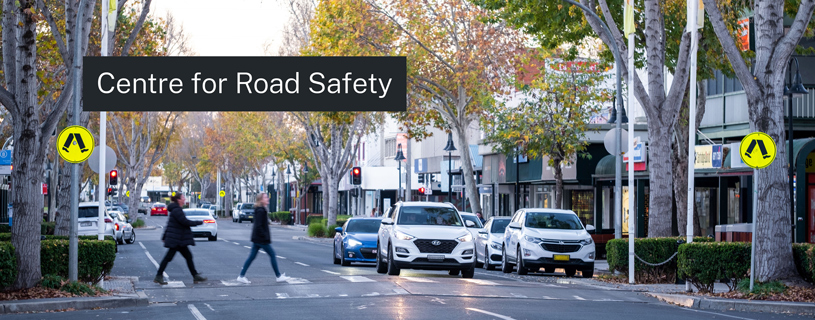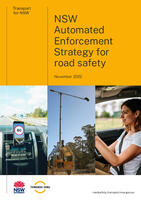Enforcement cameras
Enforcement cameras
Enforcement cameras reduce road trauma and are used in all national and many international jurisdictions.
They help drivers slow down and avoid dangerous behaviour such as running red lights. Camera enforcement is one of the most effective, evidence-based measures to increase safer driving. It saves lives and prevents injuries.
Find camera locations
Fixed and red-light speed cameras in NSW are shown on our Speed camera locations map.
The current locations of all mobile, fixed and red-light speed cameras in NSW can also be downloaded:
- Fixed speed cameras (PDF, 130.2 KB)
- Fixed speed cameras - school zones (PDF, 107.85 KB)
- Mobile speed cameras (PDF, 742.5 KB)
- Red-light speed cameras (PDF, 161.39 KB)
Our average speed camera enforcement map (PDF, 543.08 KB) shows the positions of all heavy vehicle average speed lengths in NSW.
Speed and red-light cameras
Fixed speed cameras
Fixed speed cameras are installed at high-risk locations to help reduce the incidence of speeding and crashes. These cameras can monitor multiple lanes using radar technology or detectors placed in the road surface. If you exceed the posted speed limit, a digital picture of your vehicle is taken.
A speeding vehicle can be detected and photographed even if it’s behind other vehicles.
Every fixed speed camera is accompanied by advance warning signs.
Mobile speed cameras
Mobile speed cameras are designed to detect speeding across the network by moving around to different locations at different times, to support the perception of ‘anywhere, anytime’ enforcement. They monitor multiple lanes and photograph vehicles exceeding the posted speed limit. Mobile speed cameras can be moved around at different times and locations.
Mobile speed cameras are one element of the NSW Automated Enforcement Strategy for road safety (PDF, 742.93 KB). They support police operations and other types of camera enforcement in NSW.
You'll see warning signs coming up to and after mobile speed cameras as well as a sign on top of the mobile speed camera vehicle, when they're in operation, so you know your speed is being checked.
To find out more about our mobile speed cameras, contact the Camera Enquiry Line.
Phone: 1300 782 230 (available 8.30am - 4.30pm, Monday - Friday)
Red-light speed cameras
Red-light speed cameras are installed at high-risk intersections to help reduce and prevent crashes. When a vehicle speeds or runs a red light, the cameras take a digital photo.
The cameras use vehicle tracking radar or electronic detectors placed in the road’s surface. These detectors accurately measure the speed of your vehicle. They also record when your vehicle crosses the white stop line after the lights have turned red.
There are 247 intersections in NSW that have red-light speed cameras. The locations include Sydney and regional areas and have been identified for red-light speed camera treatment using the criteria outlined in the NSW Automated Enforcement Strategy for road safety.
There are signs at intersections that tell you if red-light speed cameras are in use.
Average speed cameras
Average speed enforcement works by measuring the amount of time it takes a vehicle to drive between two points, calculating the vehicle’s average speed.
Previously in NSW, only heavy vehicles received a penalty for speeding if the vehicle’s average speed exceeds the speed limit for the length of road.
In September 2024, the NSW Government announced a trial to expand average speed cameras from heavy vehicles to light vehicles. This includes cars, motorcycles and utes.
From 1 May 2025 until 30 June 2026, a trial is being conducted in two separate locations on limited stretches of highway in regional NSW to assess whether these measures reduce speeding at these locations, improving safety and preventing injuries and fatalities.
Find out more about average speed cameras and the trial.
Nominate an enforcement camera location
You can tell us where you think cameras should operate by using our Enforcement cameras - have your say form.
Your comments along with crash data and other road safety engineering information may be used to help determine future enforcement camera locations.
Camera accuracy
Enforcement camera systems undergo a comprehensive evaluation and testing procedure. This ensures accuracy and reliability.
For fixed speed cameras, average speed cameras and red light speed cameras:
- Experts inspect each camera system before it's installed and regularly after installation. This is to check camera accuracy and operation.
- The camera recording device is inspected every 90 days. The speed-measuring device is inspected at least every 12 months. Both timeframes are in line with current legal requirements.
For mobile speed cameras:
- Mobile speed cameras have rigorous and regular testing, certification and calibration in accordance with legislated requirements.
Camera revenue
All fine revenue from enforcement cameras goes to the Community Road Safety Fund. This fund supports priority road safety programs.
Most investment in safety upgrades is spent on roads in country NSW, where two-thirds of road deaths occur.
Revenue NSW is responsible for processing and issuing infringements.
Cameras operating in warning mode
Fixed speed cameras, red-light speed cameras and average speed cameras will operate in warning mode at a new location or where the enforcement conditions have changed.
In warning mode, warning letters are used to alert non-compliant drivers and encourage a positive change in their driving behaviour. During the standard warning period, if you exceed the speed limit by 30km/h or less, you'll receive a warning letter. If you exceed the speed limit by more than 30km/h, you'll be fined and may have to attend court, lose demerit points and/or lose your licence.
However, if compliance has not reached an acceptable level, in rare circumstances warning letters may continue to be issued for low range speeding while more significant breaches result in a penalty. This helps increase behaviour change and supports higher levels of compliance over time, and is a further way in which the Government is trying to help drivers as we transition to normal enforcement mode. Drivers are reminded that they should always comply with the speed limits, not just when they know there is a speed camera. It’s the law and it saves lives - travelling at 65kmh in a 60kmh limit doubles the risk of a casualty crash.
A three-strikes scheme applies to a limited number of cameras operating in warning mode. If your vehicle has been issued two warning letters from a camera location, an infringement will be issued for a third offence and any further offences at that location.
Automated enforcement camera reviews
We monitor the effectiveness of all automated enforcement cameras in NSW.
Our reviews evaluate all automated enforcement cameras. We ensure that cameras continue to have a positive effect on driver behaviour and help reduce crashes. We review and may consider removing automated enforcement cameras that are found to be ineffective.
Documents
Some documents on this page may not comply with accessibility requirements (WCAG).
If you are having trouble accessing information in these documents, please contact us.
Automated enforcement camera reviews
2023
- NSW Automated Enforcement Camera Programs: 2023 Review (PDF, 1.25 MB)
- NSW Automated Enforcement Camera Programs 2023 Review - Technical Appendix (PDF, 22.2 MB)
2021
- NSW Speed Camera Programs: 2021 Review (PDF, 1.63 MB)
- NSW Speed Camera Programs: 2021 Review - Technical Appendix (PDF, 19.13 MB)
2020
- Annual review of speed cameras - 2020 (no appendices) (PDF, 546.11 KB)
- Annual review of speed cameras - 2020 (with appendices) (PDF, 4.84 MB)
2019
- Annual review of speed cameras - 2019 (no appendices) (PDF, 604.79 KB)
- Annual review of speed cameras - 2019 (with appendices) (PDF, 6.5 MB)
2018
- Annual review of speed cameras - 2018 (no appendices) (PDF, 471.62 KB)
- Annual review of speed cameras - 2018 (with appendices) (PDF, 3.79 MB)
2017
- Annual review of speed cameras - 2017 (no appendices) (PDF, 329.67 KB)
- Annual review of speed cameras - 2017 (with appendices) (PDF, 3.1 MB)
2016
- Annual review of speed cameras - 2016 (no appendices) (PDF, 281.53 KB)
- Annual review of speed cameras - 2016 (with appendices) (PDF, 2.85 MB)
2015
- Annual review of speed cameras - 2015 (no appendices) (PDF, 510.99 KB)
- Annual review of speed cameras - 2015 (with appendices) (PDF, 3.67 MB)
2014
- Annual review of speed cameras - 2014 (no appendices) (PDF, 228.98 KB)
- Annual review of speed cameras - 2014 (with appendices) (PDF, 3.45 MB)
2013
- Annual review of speed cameras - 2013 (no appendices) (PDF, 136.93 KB)
- Annual review of speed cameras - 2013 (with appendices) (PDF, 2.39 MB)
2012
- Annual review of speed cameras - 2012 (no appendices) (PDF, 125.09 KB)
- Annual review of speed cameras - 2012 (with appendices) (PDF, 1.87 MB)
2011
For more information
NSW will trial average speed cameras for light vehicles (including motorcycles) to assess their effectiveness to reduce speeding.
Our driver’s aid app helps manage your speed by providing visual and audible warnings if you exceed the speed limit.
Use this page to tell us where you think enforcement cameras should be located in NSW. Your submission will be reviewed by road safety experts.
Speed limits are set to manage the risk of crashes and minimise the forces that road users are exposed to, helping to reduce serious injuries and fatalties.



